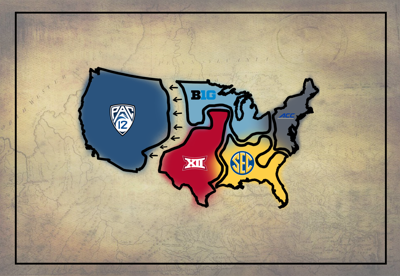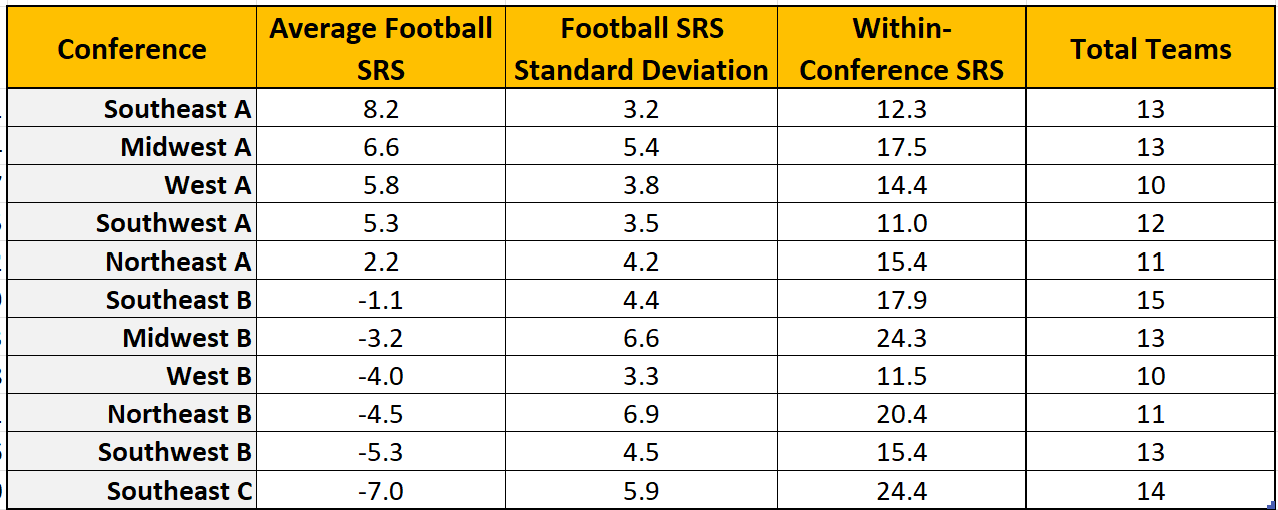A Conference Realignment That Actually Makes Sense
Using K-Means clustering to create a reasonable college sports landscape
I think I speak for the vast majority of college sports fans, especially those old enough to remember when regional rivalries actually mattered, when I say conference realignment has gotten out of hand. When Nebraska left the Big XII for the Big Ten in 2011 I, along with surely many others, were somewhat surprised and a bit disappointed by their abandonment of the classic rivalries they had with the likes of Colorado, Kansas, and Oklahoma.1 However, I respected the freedom of schools to move to conferences which best suits their needs. But we now live in a world in which UCLA flies to New Jersey for a Big Ten tilt, Stanford competes in the Atlantic Coast Conference, and the Big XII spans from Central Florida to Provo, Utah.
While I fully recognize that money is behind the lions share of this realignment, is there a conference arrangement for that actually makes sense?
Data-Driven Conference Realignment
Using program-level data for all FBS college football teams and Division 1 college basketball teams, I ran a cluster analysis, via K-Means, to attempt to correct this conference realignment nonsense.2 The statistics used were as follows…
These stats were normalized (placed on the same scale) via z-score normalization, and the schools were then categorized into one of five distinct regions: Northeast, Southeast, Southwest, West, or Midwest. I then ran a K-Means clustering algorithm within each region.
A New Football Landscape
This is the realignment, in regards to football, that resulted from this analysis.
Northeast Conference A: Boston College, Connecticut, Louisville, Maryland, Penn State, Pittsburgh, Syracuse, Virginia, Virginia Tech, West Virginia, Temple, Georgetown*, Villanova*
*-Non-Football members
Northeast Conference B: Akron, Army, Buffalo, James Madison, Kent State, Liberty, Marshall, Massachusetts, Navy, Old Dominion, Rutgers
Midwest Conference A: Cincinnati, Illinois, Indiana, Iowa, Kansas, Kansas State, Michigan, Michigan State, Missouri, Notre Dame, Ohio State, Purdue, Wisconsin
Midwest Conference B: Ball State, Bowling Green, Central Michigan, Eastern Michigan, Iowa State, Miami (OH), Minnesota, Nebraska, Northern Illinois, Northwestern, Ohio, Toledo, Western Michigan.
Southeast Conference A: Alabama, Auburn, Clemson, Florida, Florida State, Georgia, Georgia Tech, LSU, Miami (FL), Mississippi State, North Carolina State, Ole Miss, Tennessee
Southeast Conference B: Appalachian State, Charlotte, Coastal Carolina, East Carolina, Duke, Kentucky, Memphis, Middle Tennessee State, North Carolina, South Carolina, South Florida, UCF, Wake Forest, Western Kentucky
Southeast Conference C: Florida Atlantic, Florida International, Georgia Southern, Georgia State, Jacksonville State, Kennesaw State, Louisiana, Louisiana Tech, Louisiana-Monroe, South Alabama, Southern Mississippi, Troy, Tulane, UAB
Southwest Conference A: Arizona, Arizona State, Arkansas, Baylor, Colorado, Houston, Oklahoma, Oklahoma State, TCU, Texas, Texas A&M, Texas Tech
Southwest Conference B: Air Force, Arkansas State, Colorado State, New Mexico, New Mexico State, North Texas, Rice, Sam Houston, SMU, Texas State, Tulsa, UTEP, UTSA
West Conference A: Boise State, BYU, California, Oregon, Oregon State, UCLA, USC, Utah, Stanford, Washington, Gonzaga*, Saint Mary’s*
*-Non-Football members
West Conference B: Fresno State, Hawaii, Idaho3, Nevada, Nevada-Las Vegas, San Diego State, San Jose State, Utah State, Wyoming, Washington State
What Would This Change?
To see how this new landscape of college football would compare to what we have today, I analyzed the SRS scores (the Sports Reference team rating system) of the programs that would make up the new conferences, against the conferences of today.4
We see a slight decline in the range of conference SRS, indicating a narrowing of the gap between the best and worst conferences. There would be a decline in the variance in conference SRS, meaning greater parity between different conferences (i.e., less extreme differences in the average caliber of a conference). Additionally, a slight increase in the standard deviation of program SRS within conferences points toward a wider range of program quality within conferences. This results in greater talent dispersion within conferences, and when coupled with a smaller range in conference SRS, fewer "bad" or "dominant" conferences and an all-around more even playing field. On another note, schools would be much closer geographically. The average distance between teams within a conference would drop by nearly 322 miles!5
Average Distance Between Schools:
New realignment:
Today:
Rivalries Renewed
Needless to say, this would also have the benefit of reviving many regional rivalries of old, plus bring together nearby schools that have never shared a conference but have a history of hate.
Pittsburgh vs. West Virginia (The Backyard Brawl)
Oklahoma vs. Oklahoma State (Bedlam)
Washington vs. Washington State (The Apple Cup)
Georgia vs. Georgia Tech (Governor's Cup)
Florida vs. Miami (FL)
Clemson vs. Georgia
Just to name a few.
While the new conference landscape of today gives us big-time matchups week in and week out, there has been a definite shift in the balance of power. This sort of realignment I created is fun to fanaticize about, but unfortunately it will never happen as long as money is an object. For now, we can only dream…
Coming up…
Next week, I’ll publish an article about how this cluster analysis and imaginary realignment shakes out for basketball. Stay tuned!
Personally, I feel like Nebraska’s move was the first domino to fall, and kicked off the whole (albeit inevitable) realignment era.
An unsupervised algorithm that partitions data into ‘K’ clusters by minimizing within-cluster differences. It works iteratively by assigning points to the nearest centroid, updating centroids as cluster means, and repeating until convergence.
Historically was an FBS-level team, dropped to FCS in 20xx. Would return to FBS in this scenario.
Simple Rating System; a rating that takes into account average point differential and strength of schedule. The rating is denominated in points above/below average, where zero is average, although it should be noted that margin of victory has been assigned a lower bound of 7 points and an upper bound of 24 points. Non-major opponents are included as a single team in the ratings.
Talk about less travel costs!











I really enjoyed this...but found it a little bit of a sad reminder for a guy who remembers the 70s and 80s as the peak. Things today are objectively not quite right and progressively getting worse. You don't have to look far and see a Conference known as the "Big 10" somehow having 18 teams. Curious.
The reality is that college football and basketball are quickly moving away from in-person spectator sports. They're now television products. It's why the Big 10 raided the Pac-12...they wanted games from noon until 2:00 am EST, from east coast to west coast. It's why they'll soon be at the table again to carve up the ACC school - north to south. It's why geographical regions and conferences have sadly become increasingly irrelevant to the current media drenched product.
Consider that Northwestern of all places, just announced that they will build the most expensive college football stadium in the country and have designed it to hold a mere 35,000 fans at max capacity - slightly more than some 80s basketball games. Stadiums are no longer about fans in seats, but lavish media accommodations to draw more games and exposure to schools and television angles and aesthetics for viewers. Stadiums are simply a posh setting for the media and a cool backdrop for recruits and the television viewer.
At the peak, conferences mattered a ton and reflected regional differences, pride, and distinct styles of play. The Southwest Conference was decidedly southern, their teams ran the Wishbone, and their announcers and coaches spoke with an accent. The cold weather Big 10 ran too, but from a more pro-style offense that afforded at least some throws on third and long. Meanwhile, the warm weather Pac-10 was pure passing with suntans with frequent shots of the ocean. Miami versus Nebraska on New Years Day wasn't just a football game, but a clash of distinct cultures, beliefs, and styles.
Today, it's all a blended smoothie of sameness....and the blender keeps on churning.
Perhaps the greatest consequence of this race of gluttonous excess is the loss of rivalries. As the conferences and the CFB Playoffs expand to add more irrelevant teams to the mix, the regular season is marginalized. To accommodate a larger playoff and greater travel distances, the regular season will be shortened, divisions become mini conferences to alleviate travel burdens, and conference opponents will have no historical relevance to the conference. Rivalries will soon fade away and become just another game as we wait for the Playoffs in December.
And what about those Playoffs? It's easy to see that soon the Big 10 and SEC will expand again and form their own super conference with their own playoff system. They will likely comprise more than 40 teams combined, so why not? That will leave the crumbs of the current Playoff system for the "other" schools. A sort of NIT tournament to fill the gaps between March Madness games.
So, I share your enthusiasm for the old days of real conferences and rivalries but realize that while the future is unwritten, it certainly won't be written to my specifications. Much like playing those old Avalon Hill simulated war games, there will be a sense of something lost. It just won't have the same feeling or consequence as the real thing that once was. Thanks again.